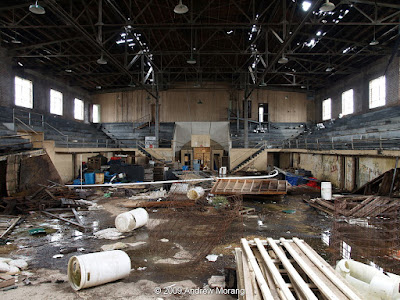
In the early 1920s, Mrs. Fannie Vick Willis Ward donated funds to the Young Men's Christian Association to build a new YMCA facility in Vicksburg. The Junius Ward Johnson YMCA at 821 Clay Street was dedicated in 1923. Fannie, a modest and generous lady, sat in the audience. The new building, a handsome brick structure with a red clay roof, was located at the intersection of Clay and Monroe Streets in what was then the bustling heart of a thriving commercial and industrial city. Originally, the building had only three floors, but in 1925, workers removed the roof and added a fourth floor with 33 more residence rooms.

The new building was state-of the art at that time and featured steam radiator heat, bathrooms on each of the residence floors, a gymnasium/theater, and a swimming pool in the basement. The pool was tiled and of the most modern, sanitary construction according to standards of the 1920s.


When I moved to Vicksburg in the 1980s, the lower two floors were still regularly used for civic functions. The swimming pool was the only one in town with heat for winter use. I do not know the original configuration of the locker room. A ladies changing room had been added, but this would not have existed in the 1920s.
 |
| YMCA swimming pool in 2005 (Tri-X film, Tachihara 4×5" camera, 75mm ƒ/8 Super-Angulon lens) |
On the 3rd and 4th floors, young gentlemen could rent a modest and clean room for weeks or months. This was a common practice in the early-mid-20th century and was less expensive than staying in a hotel. My father lived in YMCAs in the 1930s and 1940s in Providence, Boston, New York, and other cities for periods of weeks at a time.


Up through the 1970s, it was still common practice for single men newly-hired at the Waterways Experiment Station to live in the "Y" for months or sometimes years. They had to dine somewhere else, a service that was fulfilled by boarding houses in the vicinity. The normal pattern was for the young gent to eventually meet a young lady via church, sports, or club activity, get married, and then move to a suburban house. The gentleman in the photograph below is a former resident. He was a world-famous earthquake mechanics scientist in the Geotechnical Laboratory.

Another friend and coworker said when he moved to the "Y" in 1968, the rent was $30/month. For breakfast, many of the gents went to Crawley's Pool Hall, which put on a generous spread for $1. In the evening, they ate at the Glass Kitchen for a home-style $1 dinner or at other downtown eateries. Every night from 7-9 pm, a basketball game was open to anyone, after which the guys would go out to a bar for a beer. At that time, there were numerous bars downtown.


On our contemporary standards, the residence rooms are tiny, cramped monk's cells with a narrow bed and one electric outlet. The one tiny closet would barely hold our clothes, let alone all the other junk we drag around as part of our modern lifestyle. The rooms were not air-conditioned, but the doors had wood louvers. In hot weather, hall fans provided a constant breeze, and by leaving a window open, a breeze would keep the rooms bearable (on pre-1970s standards).
 |
| Residence room (Kodak Panatomic-X film, Rolleiflex 3.5E camera, 75mm Xenotar lens) |

The Junius Ward residence floors ceased operation between 1978 and 1980. First, the YMCA closed the upper 33 rooms on the fourth floor, and then closed the third floor. This was the result of increasing competition from apartments around town, and possibly also a trend for YMCAs to convert to family-style recreation facilities. With lack of use, this part of the building deteriorated steadily thereafter.

Vicksburg YMCA moved to a new location in 2002 and sold their historic Clay Street building to a Nashville developer, who planned to convert the space to condominiums. The plans never materialized. The building remained unoccupied until about 2003 or 2004, when Keystone Ministries moved in. Pastor James Hartley kindly let me take photographs at that time. The ministry did some renovations, but the building needed too many repairs for them to be able to continue. Since about 2006, the building has been unused. Several potential developers have looked, but the cost of renovations has scared them off. Before it could be reoccupied, it would need fireproof stairs, major roof repair, and other significant upgrades. It languishes empty, slowly deteriorating.

Photography technical notes:
- Rectangle black white photographs: Taken in 2005 with Kodak Tri-X Professional film in a Tachihara 4x5 inch camera.
- Square black and white: Kodak Tri-X film and Panatomic-X in a Rolleiflex 3.5E camera (75mm ƒ/3.5 Xenotar lens)
- Square color: Kodak Ektar 25 Professional film in a Rolleiflex 3.5F camera (75mm ƒ/3.5 Planar lens)
- Rectangle color: Kodak Kodachrome 25 film in a Leica rangefinder camera
Click any photograph to enlarge it. Thank you to many Vicksburg friends who provided information and history.
UPDATE: March 2025, the old Y remains empty with no signs of activity or renovation.


















































